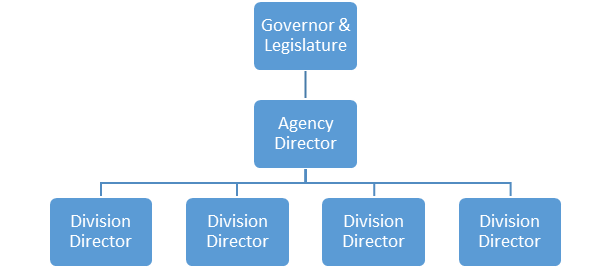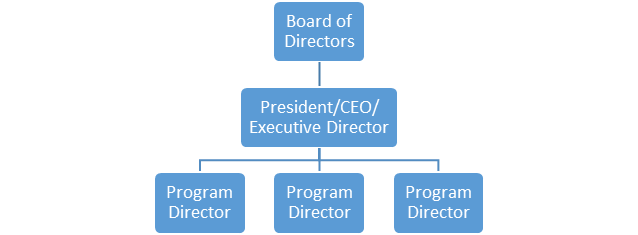3.3 Understanding the Agency Hierarchy and Structure
Now that you are aware of the hows and whys of an agency, it is time to increase your familiarity with those who are in your agency. Every organization has formal and informal structures, which contribute to the intentional and unintentional culture of that organization. This section will review some of the factors that influence the structures agencies use and inform their culture.
3.3.1 Formal Structures
Organizational charts, job descriptions, employee handbooks, and policy and procedure manuals are the most common ways for an agency to demonstrate their formal and supervisory structure. They are hierarchical by design, even when an agency holds the value of shared leadership, or the concept that you can lead from any position. Organizational charts allow for monitoring entities to know who in the agency is responsible for specific duties, who reports to whom, and how the work of the agency is organized. These are all critical parts of maintaining licenses and accreditations, which may be connected to funding streams. Knowing the supervisory hierarchy is also important if an employee is having performance issues, is experiencing workplace harassment, or on a more positive note is being recognized outside of their unit for exceptional work.
There are basic organizational charts for both public and private agencies. The examples used in this section are a broad overview and generalized for most agencies. Your organization may have variations, but the concepts are generalizable.
Public agencies start with the state governor and state legislature at the top of their charts as funding. The laws that inform the policies and procedures come directly from those two entities. That is followed by the director for each agency, followed by division directors, and so on, until all employees are listed within their supervisory units. Figure 3.3 a simple chart that shows the basic structure.

Figure 3.3 Basic structure for a public agency showing the government at the top, the agency director next, and then all other directors below the agency director.
Private agencies have a similar structure, with the board of directors at the top of the chart, followed by the top agency executive such as the president, chief executive officer, or executive director. Much like a public agency, the next level is the program directors, followed by their teams who provide direct services. Figure 3.4 shows a simple representation of a private agency organizational chart.

Figure 3.4 Basic structure of a nonprofit organization which shows the Board of Directors at the top, the agency CEO next, and all program directors reporting to the CEO.
Organizational charts help you as an intern begin to see how your field experience site has formed itself and who might know the answers to some of your questions and who the identified leaders are. It can give you a broader understanding of the entire agency, not just the unit where you will be learning and working. It is also a visual representation of how information in the agency is officially communicated. Think of an organizational chart as a map of the agency.
3.3.2 Informal Structures
Formal organizational systems keep an agency moving forward in a predictable and planful way. They are, as the label suggests, written down, documented, and prescribed. However, since human services agencies are filled with humans and not machines, there are several informal systems that you will need to be aware of and pay attention to in your role as an intern.
Informal systems include how information flows, specifically unofficial communication, sometimes referred to as gossip. Gossip has a bad reputation, much of which is deserved. However, the informal streams of communication exist in every organization and can be toxic to agency culture, or they can be used as a tool to provide information prior to formal distribution. For example, before the budget is released through formal channels, a supervisor could let the most “communicative” member of the team know the overview for their department, whether it is budget cuts, increases, or no changes. The communicator is likely to then share that information with peers and colleagues prior to the budget meeting, alleviating the stress of not knowing. As an intern, it is good to identify the informal channels of communication, but not participate in them.
Leadership is also both formal and informal. While there are identified agency supervisors, you will notice that within every team there is an informal hierarchy of leadership. Informal leadership is the ability of a person to influence the behavior of others by means other than formal authority conferred by the organization through its rules and procedures.
Informal leadership is basically any type of leadership that is not based upon formal authority (Grimsley, 2022). This may be based on seniority, expertise, or personality. Watch for who sets the tone of meetings. Is it the supervisor or one of the team members? Who on the team is the first one to set boundaries or confront non-productive behavior? Who eats lunch with whom? What are the values of the individual teams and units within the agency? How does agency history inform internal conflicts? Informal leadership can have a negative impact on an organization if it is coercive or oppressive. If that occurs, it must be addressed formally using the organizational structure.
The formal and informal structures meld together to form agency culture. Culture is formed intentionally and unintentionally. As an intern, you will have an opportunity to observe and provide feedback about the productive and unproductive aspects of the agency culture, which will be discussed in the next section.
Here are some questions about organizational structure that you as an intern might find helpful:
- Do you have a copy of/access to your agency organizational chart?
- What informal structures have you noticed? Is it the norm to bring lunch or go out to lunch?
- Who are the formal and informal leaders in the agency?
- What does your supervisor want your role to be in team and staff meetings?
Understanding both the formal and informal structures of an agency can help you navigate the work more smoothly and efficiently.
3.3.3 Managing Up
Books and articles have been written about the concept of managing up, which is the practice of using the traits of the identified leader to help you be the most productive employee. Luke Wiesner, a conflict resolution coach for the University of California, Merced, offers these guidelines for what managing up is and is not:
- NOT supervising or overseeing your boss
- NOT going above your boss’s head to have your voice heard
- NOT evaluating or judging your boss’s management or leadership style
- NOT about changing or developing your boss into a better manager or leader
- NOT about challenging decisions or actions your boss takes
- Managing your relationship with your boss
- Developing and cultivating a productive working rapport with your boss
- Learning your boss’s management, leadership and communication styles and preferences
- Increasing your awareness of your own work and communication style and preferences
- Adapting and aligning the work styles of you and your boss to form a productive working relationship centered around mutual growth and understanding, work productivity and career development. (Wiesner, n.d.)
In the Harvard Business Review article “What Everyone Should Know about Managing Up,” managing editor of HBR’s Insight Centers Dana Rousmaniere identifies the following actions as important for any employee wanting to improve their performance:
- Anticipate your boss’s needs and ask how they prefer to have problems or concerns communicated.
- Disagree respectfully and productively.
- Build and maintain trust with your boss.
- Be friendly, but don’t assume a friendship with your boss.
- Be helpful and make your boss look good by doing your job and doing it well. (Rousmaniere, 2015)
The key in all relationships, formal or informal, is to be authentic, honest, and impeccable with your word.
3.3.4 Licenses and Attributions for Understanding the Agency Hierarchy and Structure
“Understanding the Agency Hierarchy and Structure” by Sally Guyer MSW is licensed under CC BY 4.0.
Figures 3.2 and 3.3 created by Sally Guyer MSW are licensed under CC BY 4.0.
“Managing Up” by Elizabeth B. Pierce is licensed under CC BY 4.0.
